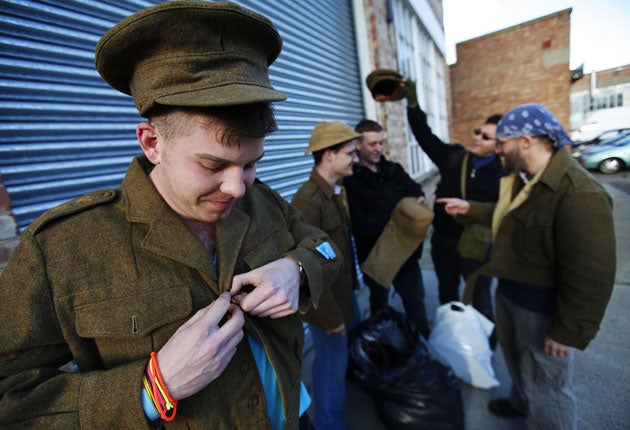Pack up your bargains in your old kitbag
A Slice of Britain: Shoppers queue from 2am as Angels sells off the uniforms that fought wars on stage and screen

The first cars begin arriving at 2am on Saturday morning. By 5am a queue of people folds around the building, to stand for hours in the bitter cold in the hope of beating the 2,000 other shoppers desperate for the treasures on offer inside. This isn't the first day of the Harrods sale, and none of the shoppers is remotely interested in cut-price flatscreen TVs or bargain designer sunglasses. Not when there are Second World War fighter-pilot uniforms, khaki tin helmets and battered metal breastplates to be had.
The warehouse at the business park in Wembley – the setting for the massive sale of 250,000 pieces of second-hand military uniform – is bland, nondescript; the scene inside anything but.
While some visitors might be shopping for plays or fancy dress parties, for Wesley Crabb, and for people like him, such sales are a chance to replenish their daily wardrobe. With his slim frame clad in a green 1940s tweed suit, his thin moustache and carefully oiled hair, the 41-year-old could have wandered straight out of an episode of the BBC's time-travel series Goodnight Sweetheart.
"We don't dress up," he said. "We live it. Everything I have is from 1900 to 1950... my house, cars, clothes. I started collecting about 12 years ago, but it takes a long time. Everything I earn goes on it."
In the three cavernous rooms around him, middle-aged military enthusiasts rub shoulders with bespectacled teenagers and glamorous young women in bright lipstick and fur coats, all rummaging on rails of clothing dating from 1900 to 1990. These are being sold off by Angels, the London costumiers, which has supplied clothes for productions that range from Saving Private Ryan via Dad's Army to Band of Brothers.
The surging crowd is, to put it politely, an eclectic bunch with no shortage of off-the-peg British eccentrics. But many, like military fans Michael Hargrave and Halil Bulukbashi, also look as if they would be more suited to the trendy environs of Hoxton or Shoreditch in London's East End. Twentysomething girls rummage through stacks of navy military jackets, which, at £20, are bargains compared to the wares at the average vintage clothes shop.
"I wanted a military cap to wear on nights out, and I've found three," says 22-year-old Nikki Frances, a museum worker. "You see similar things in Topshop but these are much better, as they are authentic."
A man with dirty clothes and badly lacerated fingers leaves clutching a bin-bag full of clothes, admitting he buys second-hand military garments not because he likes the style, but because they are cheap and long-lasting.
All the costumes, which cost between £5 and £30, have been worn on stage or screen. Many will get another chance to take centre stage – at local history society re-enactments, say.
Buyers such as Chris Davies, 22, a member of the Living History group which operates at The Royal Artillery Museum in Woolwich, south-east London, have already planned precisely what they will do with their purchases. "On 13 December," he says, "we will be portraying an anti-tank detachment from World War Two. It is like being in a film; I guess that is why I like it. I've spent £200 on clothes today, and I don't wear them for anything else, just keep them for the re-enactments."
Alongside First and Second World War uniforms on the rail nestle Irish Garda jackets, navy, woollen, French army jackets with gold epaulettes, and green camouflage jumpsuits. Anyone hoping for Corporal Jones's Dad's Army uniform or Tom Hanks's Private Ryan gear is disappointed; the collection's most valuable pieces have already been auctioned at Bonhams, and the rest are not labelled to reveal the films in which they have appeared.
And, like everything else, the war-costume business can feel the hot breath of technology at its heels.
"The sale is being held because there simply isn't the demand for this volume of military costumes anymore: we're trying to clear space, not make a profit," says Tim Angel, the CEO of Angels and the fifth generation of his family to head up the brand that bears his name. "When we made The Longest Day [1962], there were 2,000 uniforms, but now computer-generated imagery means that studios need far fewer. Even on a film like Saving Private Ryan, they used 400 uniforms and computer-generated the rest."
Join our commenting forum
Join thought-provoking conversations, follow other Independent readers and see their replies
Comments
Bookmark popover
Removed from bookmarks